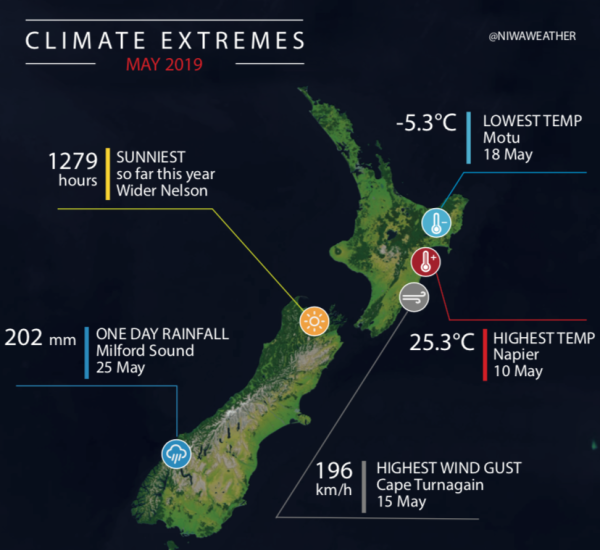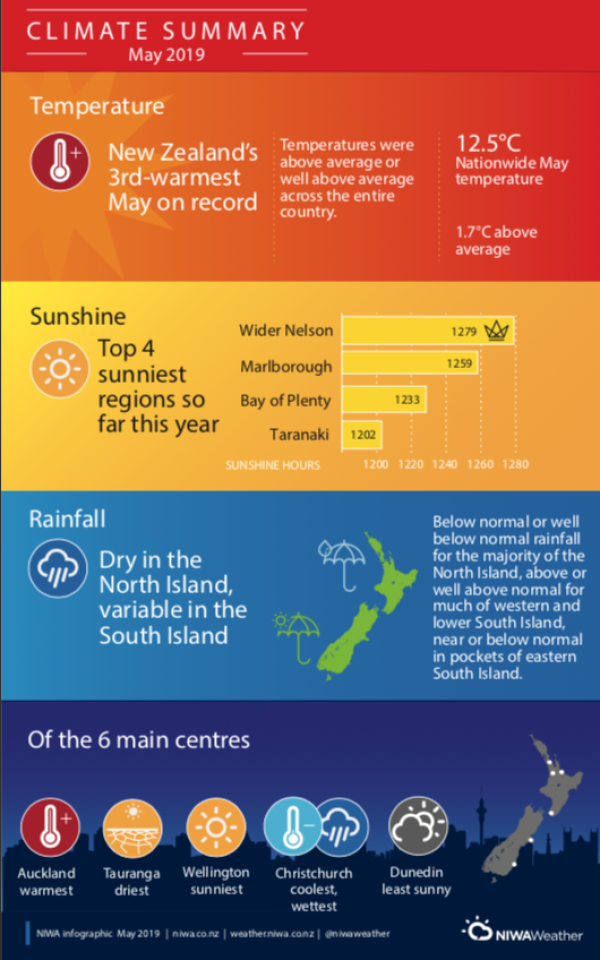New Zealand’s 3rd-warmest May on record
|
Temperature |
Temperatures were above average (0.51°C to 1.2°C above average) or well above average (>1.2°C above average) across the entire country, with the most unusually warm temperatures in the South Island. Many locations observed record or near-record warm mean, mean maximum, and mean minimum May temperatures. |
|
Rainfall |
Rainfall was below normal (50% to 79% of normal) or well below normal (<50% of normal) for the majority of the North Island, with the exception being parts of Waikato, Taranaki, and coastal Manawatu-Whanganui where rainfall was near normal (80% to 119% of normal). Rainfall was above (120% to 149% of normal) or well above (>149% of normal) normal for much of western and lower South Island. Near or below normal rainfall occurred in parts of Marlborough, Canterbury, coastal Otago, and southern Southland. |
|
Soil Moisture |
As of 31 May, soils were drier than normal for much of the North Island with small areas of wetter than normal soils about western Waitomo and the Kapiti Coast. South Island soil moisture was generally near normal with pockets of below normal soil moisture about Waimate and Waitaki as well as the interior Marlborough region. |
Overview
May 2019 was characterised by higher than normal sea level pressure over and to the east of the North Island and lower than normal pressure to the south of the South Island. This resulted in more northwesterly winds than usual over the country. The distinct lack of southerlies throughout the month, frequent rounds of high pressure and warmer than average seas contributed to unseasonably warm temperatures and what is now officially New Zealand’s 3rd warmest May on record.
The nationwide average temperature in May 2019 was 12.5°C (1.7°C above the 1981-2010 May average from NIWA’s seven station temperature series which begins in 1909).
Dry conditions were observed across much of the North Island and parts of eastern South Island with monthly rainfall totals below or well below normal for the time of year. Conversely, the majority of western and lower South Island received rainfall totals that were above or well above normal.
With frequent bouts of high pressure there were relatively few significant weather events during the month of May, however, an active low pressure system from the Tasman Sea brought an unsettled Mother’s Day weekend (11-12 May) to many, and the month ended on a stormy note as a series of fronts brought rain, thunderstorms, snow and strong winds (refer to the highlights and extreme events section for further details).
Further highlights:
- The highest temperature was 25.3°C, observed at Napier on 10 May.
- The lowest temperature was -5.3°C, observed at Motu on 18 May.
- The highest 1-day rainfall was 202 mm, recorded at Milford Sound on 25 May.
- The highest wind gust was 196 km/h, observed at Cape Turnagain on 15 May.
- Of the six main centres in May 2019, Auckland was the warmest, Christchurch was the coldest and wettest, Tauranga was the driest, Wellington the sunniest and Dunedin the least sunny.
- Of the available, regularly reporting sunshine observation sites, the sunniest four regions in 2019 are Wider Nelson (1279 hours), Marlborough (1259 hours), Bay of Plenty (1233 hours) and Taranaki (1202 hours).
Download
New Zealand Climate Summary May 2019 [PDF 5MB]
New Zealand climate statistics May 2019 [PDF 70KB]



